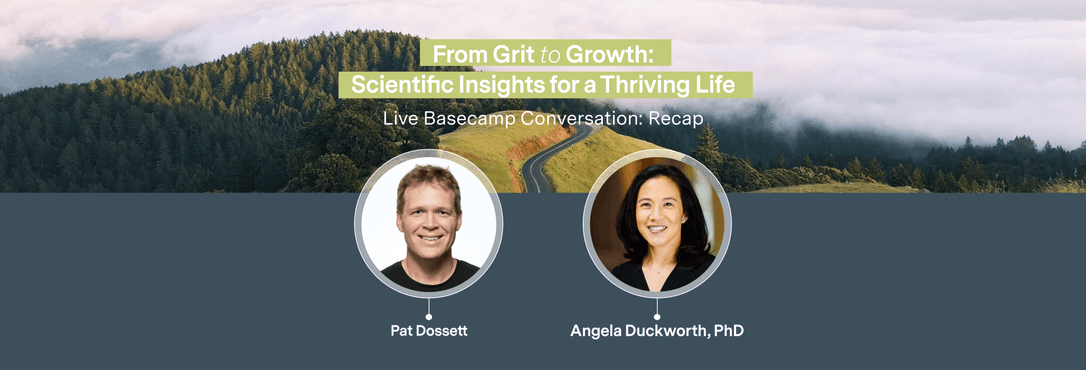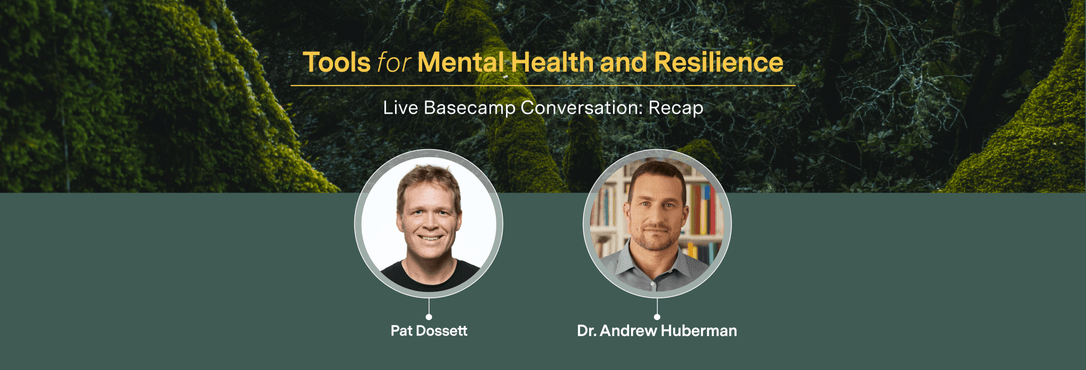New Year, New You
Madefor Lead Scientific Advisor and Neuroscientist, Dr. Andrew Huberman, joined Madefor Co-Founder and former Navy SEAL, Pat Dossett, for Basecamp. With a new year just around the corner, they discussed change and what fatal mistake most people are making when they try to make changes in their behavior or thought patterns. Dr. Huberman and Pat presented a step-by-step protocol for maximizing your success at making lasting change in 2022 while increasing overall neuroplasticity, allowing change to happen faster and easier in the future.
Part One: Letting Go
New Year’s Day always comes with the infamous New Year’s Resolution. The idea of making ourselves better in this newer year is well-intentioned, but those changes often don’t make it out of the month much less the year. Dr. Huberman pointed out that when we go to make these changes, it’s a two-part process that is often reduced down to simply starting a new habit instead of addressing how we remove old ways of thinking and acting that will ultimately undermine our healthy goals. There are two parts to making lasting changes: letting go and grabbing hold.
Before we can make real changes, we have to understand how we are wired. We have reflexive actions and thought patterns that are the nexus of our habits. There are certain things we know are barriers to forward progress like procrastination, lack of energy, or too much nervous energy that brings with it a lack of focus. But when we are looking to start a new healthy habit, be it a behavior or way of thinking, we need to consider first the behaviors and thought patterns that are preventing us from moving forward in the way we’d like. We have to unlearn a less-desirable behavior or thought pattern before we can learn a new positive one.
We have to "un-do" the knot currently in the nervous system that hardwires a thought or behavior, and that only happens through deliberate action. To do this in the nervous system, we need to create a long-term depression (note: this is not psychological depression) between the two neurons that result in the behavior or thought pattern. We want to reduce the likelihood of Neuron A sending a signal to Neuron B to produce the negative behavior, which would then uncouple the reflex.
How do you do that? Here’s an easy way to remember it using 3 As.
The 3 Steps of Letting Go:
- Assess and identify the thing that isn’t serving you.
- Articulate exactly what it is that you want to let go in terms of thought or behavior. Be as precise as possible.
- Attribute the positive effects you will derive from letting go of that particular behavior or thought pattern (this step dictates that letting go will affect your physiology).
Here is an example of how this process works. Let’s go through the process:
- Assess and identify: I want to stop getting on my phone the moment I wake up in the morning.
- Articulate: I would like to stop picking up my phone, looking at my phone, and wasting so much time on it. Spending any more than 60 seconds on the phone first-thing in the morning is not good for me. My phone is not providing the quality of light I need in the morning. I cannot control what I see on my phone and it could set a negative tone for my day.
- Attribute: I could spend that time to get quality sunlight, ease into my morning, or meditate instead of jumping on social media or email.
Ideally, you should only choose one behavior at a time to change and you’ll have a higher rate of success if you write it, speak it aloud, and tell someone.
Part Two: Grabbing Hold
Now that we've covered how critical the letting go part is to make changes, let's talk about the second part, grabbing hold. After we start undoing the reflex, we are going to introduce and install the new habit or thought pattern by replacing and reinforcing it by enacting long-term potentiation.
Long-term potentiation is the deliberate strengthening of the signal transmission between neurons. We are going to create a new connection and then reinforce it repeatedly. This is a key part of developing greater neuroplasticity that will not only help with this individual action or thought pattern but will improve your neuroplasticity overall. Now that you’ve decided to stop checking your phone first thing in the morning, you can replace that behavior with taking a short walk in the morning, for example.
The brain never really takes out the trash, so to speak. It keeps everything in an off-server file in case it's needed again. This is why we can't just introduce a new habit once and then do it forever. We have to continually have wins and reinforce the behavior for it to become reflexive. When we experience success, we get little surges of dopamine that give us the equivalent of physiological cookies to continue a behavior. To keep getting those surges, we have to do the behavior often enough that it's meaningful enough for a dopamine celebration, but not so far out that we set ourselves up for failure. Dr. Huberman called this setting the time-horizon or time-window.
If you know you'll meet the new behavior or thought pattern with a lot of resistance, you should shorten the time horizon. If the new behavior won’t be met with a lot of resistance, lengthen the time horizon. Dr. Huberman suggested daily or half-day checklists to get started. Lengthen the time horizon to maintain the change. If you fall off a bit, go back to a shorter window. There is no one-size-fits-all standard for how long it takes to break or make a new behavior. You need to practice self-directed horizon control to maximize your success.
The Step-by-Step to Creating Lasting Change
Ready to get started? Let go of the old and grab hold of the new! Let’s put it all together so you can get started on a stellar 2022 as soon as possible.
- Assess and identify the behavior or thought pattern that isn’t serving you.
- Articulate exactly what it is that you want to let go in terms of thought or behavior. Be as specific as possible.
- Attribute the positive effects you will derive from letting go of that particular behavior or thought pattern (this step dictates that letting go will affect your physiology).
- Write it down, Speak it aloud, Tell a friend.
- Replace the old behavior or thought pattern with a new one.
- Reinforce and Repeat the behavior or thought pattern. Make adjustments as needed by practicing self-directed horizon control to choose a window of time for the change.
You get better at unlearning and learning in general when you have compounding successes. Remember to choose one behavior or thought pattern at a time and work it until it is automatic. Once you've cemented the first one, only then should you move on to the next. You got this!



